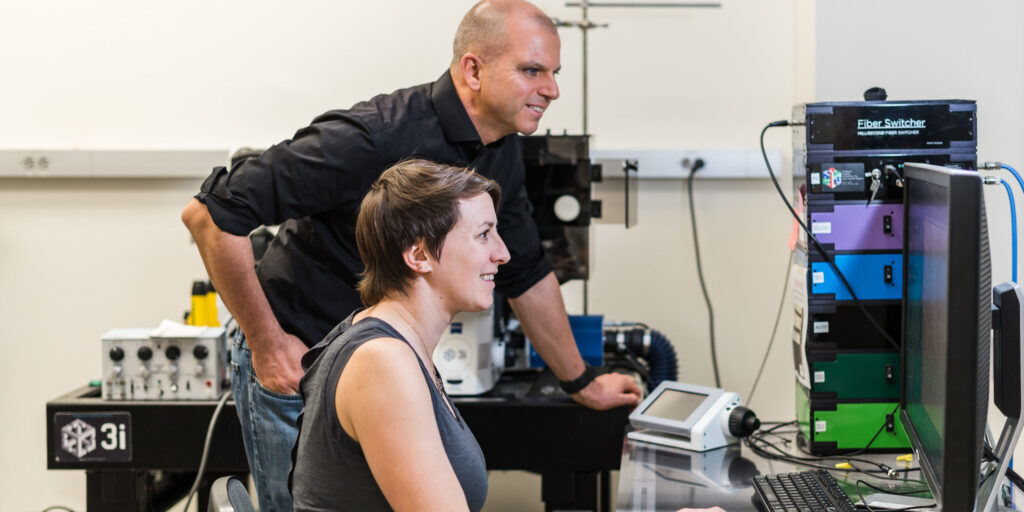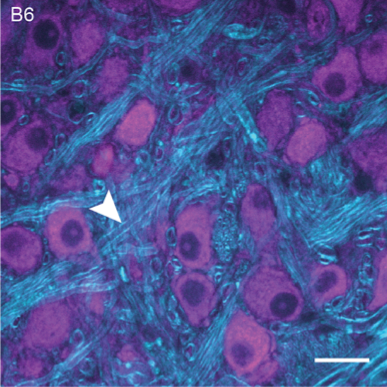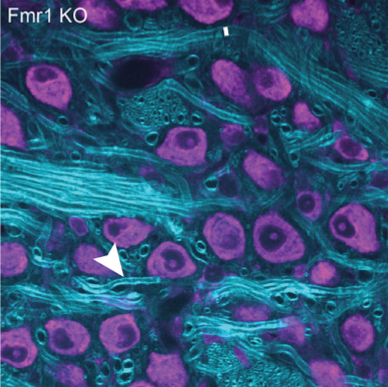Auditory Dysfunction in Fragile X Syndrome in a Mouse Model of Fragile X

Achim Klug, PhD
Principal Investigator
Elizabeth McCullagh, PhD
FRAXA Postdoctoral Fellow
University of Colorado at Denver
Denver, CO
Summary
With a $90,000 grant from FRAXA, Dr. Achem Klug and Dr. Elizabeth McCullagh at the University of Colorado investigated whether auditory neural circuits are altered in Fragile X mice.
The Results
They saw minor differences in these mice compared to control mice in several measures of auditory acuity. Fmr1 mice had increased latency to the startle response for almost all conditions compared to B6 mice, suggesting altered timing to acoustic cues. They also showed decreased prepulse inhibition (PPI). These experiments show that, consistent with patient reports and anatomical/physiological data, the auditory system is altered in a mouse model of FXS, though with some potential compensation leading to a subtle behavioral impact.
The team's findings, Mechanisms underlying auditory processing deficits in Fragile X syndrome, were published in PubMed on February 10, 2020.
The Science
The Cocktail Party Effect
Imagine a world where to sit in a noisy classroom is intolerable, and even painful. You can’t focus on the teacher because there is too much background noise. Hypersensitivity to sound and impaired sound localization are some of the most common sensory symptoms described by people with Fragile X syndrome (FXS) and more broadly autism. The sound localization pathway, a neural network within our auditory system, enables us to not only localize the location of a sound source, but also to separate between multiple simultaneous sounds that enter our ears. This is the aptly named “cocktail party effect.” Whenever we converse in a crowded restaurant, airport, or train station, we rely on our sound localization circuit to parse this complex situation into multiple narrow spatial channels based on their location. This process of sound localization is performed in the auditory brainstem and forms the neural basis for our cognitive ability to focus on the sound source of interest (which happens in much higher order brain areas).
Being unable to localize the source of a sound, and more importantly, to focus on a conversation when distracting noises are present, significantly impairs social interactions. Despite its importance, our understanding of how the sound localization circuit is impaired in FXS is largely unknown.
Experimental Plan
To explore alterations in the sound localization pathway in FXS and autism, this team is using a mouse model for FXS, the most common genetic form of autism. Dr. Elizabeth McCullagh is exploring sound localization deficits in FXS using both measurements of populations of cells in the brain and behavioral experiments. She is also using these techniques to help screen for drugs that might rescue auditory processing in FXS.
Specifically, Dr. McCullagh is using an electrode array on live tissue sections of FXS mice to measure the intact sound localization brain circuit. She is also measuring the auditory brainstem response (ABR), an in vivo assay of compound activity among auditory neurons in response to sound stimuli, as well as pre-pulse inhibition (PPI) measurements, which are a behavioral assay of sound localization deficits and hypersensitivity in these mice. Lastly, she is starting a new project exploring if speed of transmission in the sound localization circuit might be impaired in FXS mice and explain deficits seen in sound localization processing.
A New Biomarker for Future Treatment Trials
The results from these experiments will help advance the treatment of FXS by giving insight into how excitation and inhibition are imbalanced in the sound localization pathway. Being able to treat just auditory hypersensitivity and sound localization difficulties would be an important milestone. However, because the sound localization pathway is a relatively well understood neural circuit and thus the biological significance of these imbalances is relatively easy to assess, these findings can hopefully be extended to imbalances in other areas, particularly in other sensory systems. If clear differences are found, they could be used as potential biomarkers for future Fragile X clinical trials.
There is a reduction in diameter of myelinated fibers in Fragile X mice, as compared with typical mice, and this may reflect sound localization deficits.
Grant Post Revisions
- 2021/04 - Added The Results.
- 2017/06 - Original grant post published.



